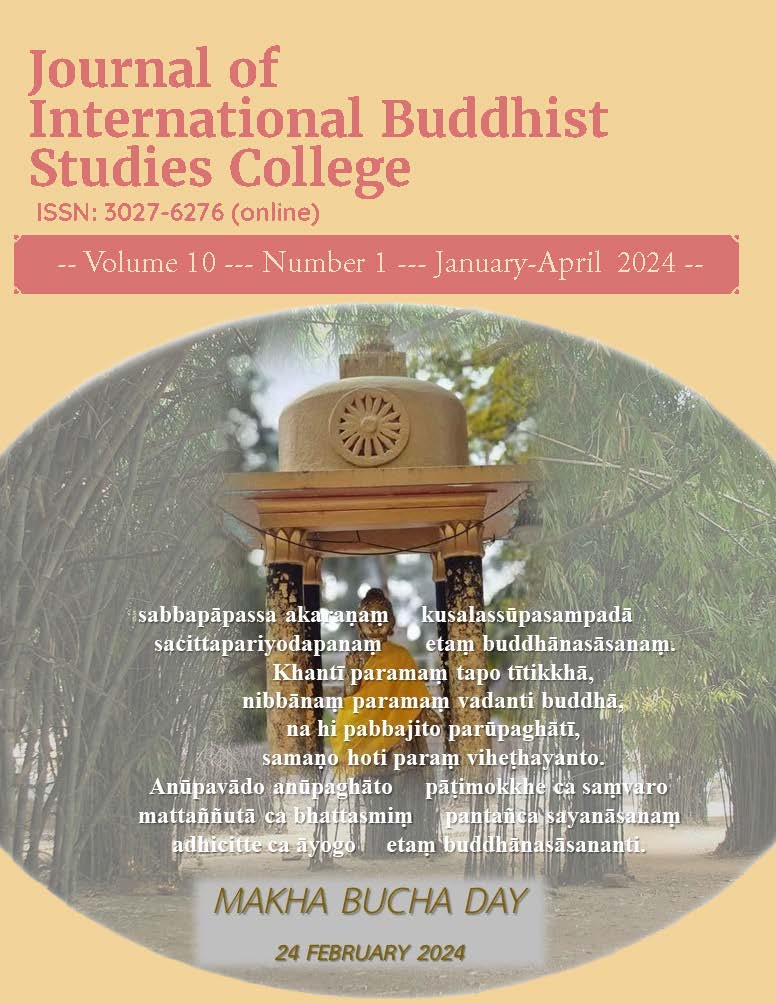The Process of Promoting Peace by Buddhist Peaceful Means for Undergraduate Students of Jinarakkhita Buddhist College, Indonesia
Main Article Content
Abstract
This study has three objectives: 1) to explore the problems of undergraduate students at Jinarakkhita Buddhist College (JBC), 2) to study the process of promoting peace through Buddhist Peaceful Means, and 3) to propose the process of promoting peace based on Buddhist Peaceful Means for undergraduate students at JBC. The data collection methods employed in this research encompassed documentary analysis and in-depth interviews, with the research methodology adopting an inductive content analysis approach.
The outcomes of the study encompass the identification of the issues encountered by undergraduate students at JBC, an examination of the process of promoting peace in line with Buddhist Peaceful Means, and the proposition of a strategy for fostering peace among JBC’s undergraduate students based on Buddhist Peaceful Means. Through the analysis of the gathered data, the researcher advocates for the implementation of a peace promotion strategy grounded in Buddhist Peaceful Means for the undergraduate student body at Jinarakkhita Buddhist College. This strategy, termed PKRW (Peaceful facilities, Kind community, Right communication, Wise heart), emphasizes the importance of specific amenities for negotiation and mediation, as well as cultivating a positive school environment. Furthermore, the formation of a supportive community, encompassing familial support and positive friendships, is deemed pivotal in this process. Effective communication practices such as collaborative problem-solving, open dialogue, and active listening are essential components, while the cultivation of qualities like empathy, mindfulness, and compassion are encapsulated within the concept of the wise heart. The application of Buddhist peaceful means within the PKRW framework reflects the essence of the Threefold Training (comprising the Five Precepts, mindfulness, and wisdom through learning). The proposed framework underscores the enhancement of individual and collective well-being, utilizing Buddhist peaceful means to address student issues and foster a peaceful environment. By integrating facilities, community support, effective communication, and mental training within academic settings, the cultivation of inner and outer peace can be achieved. These key elements are integral in promoting peace among undergraduate students, leading to overall improvements in college performance and sustainability.
Article Details
The Journal of TCI is licensed under a Creative Commons Attribution-NonCommercial-NoDerivatives 4.0 International (CC BY-NC-ND 4.0) licence unless otherwise stated. Please read our Policies page for more information on Open Access, copyright and permissions.
References
Andriyaningsih, A., Sutawan, K., & Sumarwan, E. (2023). The Influence of Silent Sitting and Mindful Parenting on Interest in Learning The Students of STIAB Jinarakhita Lampung. Journal of Education, Religious, and Instructions (JoERI), 1(2), 64-73.
Bachmann, J. & Schouten, P. (2018). Concrete approaches to peace: infrastructure as peacebuilding. International Affairs, 94(2), 381-398. https://doi.org/10.1093/ia/iix237
Baptiste, N. & Salfo, O. (2021). The Role of Communication in Conflict Resolution and Peacebuilding. Review University Without Border for the Open Society (RUFSO), 24 (15), 1-8. http://www.rufso.org/publications2
Bunthavee, P. (2020). Buddhism: The Social Innovation for Peacebuilding and Harmony. Journal of International Buddhist Studies, 11(1), 37–41.
Gangabhushan M., M. (2017). Buddhism and Peace Promotion. Asia Pacific Journal of Religions and Cultures, 1(1), 1–15. https://so06.tci-thaijo.org/index.php/ajrc/article/view/239982
Hanh, T. N. (2004). Creating true peace: Ending violence in yourself, your family, your community, and the world. Simon and Schuster.
Howard, J. (2018, September 5). Half of World’s teens face peer violence at school, UNICEF says. CNN. https://edition.cnn.com/2018/09/05/health/school-violence-statistics-unicef-study-parent-curve-intl/index.html
Isabu, M. O. (2017). Causes and management of school related conflict. African Educational Research Journal, 5(2). 148-151. https://www.netjournals.org/pdf/AERJ/2017/2/17-027.pdf
Kilag, O. K. T., Mambaje, O. C., Rabi, A. A., C. Uy, J., Miñoza, E. G., & Padilla, J. B. G. (2023). The practice of peace education: applied research on peace education in the twenty-first century. European Journal of Higher Education and Academic Advancement, 1(2), 82-91. https://doi.org/10.61796/ejheaa.v1i2.104
Liu, X., Xu, W., Wang, Y., Williams, M. G., Geng, Y., Zhang, Q. & Liu, X. (2015). Can Inner Peace be Improved by Mindfulness Training: A Randomized Controlled Trial. Stress and Health, 31, 245–254. https://doi.org/10.1002/smi.2551
McConnell. (2009). Between Meditation and Peace-making. In The Most Ven. Prof. Dr. Phra Dharmakosajarn (Ed.), Buddhist Approach to Political Conflict and Peace Development. (pp. 209-224). Mahachulalongkornrajavidyalaya University.
Nizeyimana, J. B., & Ouedraogo, S. (2021). The role of communication in conflict resolution and peacebuilding. Review University Without Border for the Open Society (RUFSO), 24(15). http://www.rufso.org/publications2
Pandey, K. S. & Kaur, S. (2019). Buddhist Approach to Sustainable Peace. In T.D. Thiem & T.N. Tu (Eds.), Mindful Leadership for Sustainable Peace. (pp. 521-539). Vietnam Buddhist University Publications.
Penyusun, T. (2020). Strategic Plan Document (Renstra) 2020-2030 (Dokumen Rencana Strategis (Renstra) Tahun 2020-2030). STIAB Jinarakkhita.
Phansawang, J., Phrakhru Sudhikhambhirayan, Saengsai, P., Sukumal, P., Klaydesh, P., Kenaphoom, S. (2021). Buddhist Education: The Noble Path to Peace. Journal of Management Information and Decision Sciences, 24(Sp. 6), 1-6.
Phramaha Hansa Dhammahaso. (2004). Patterns of Conflict Management by Buddhist Peaceful Mean: A Case Study of Mae Ta Chang Basin, Chiangmai [Doctoral dissertation, Mahachulalongkornrajavidyalaya University].
Purwadi, P., Saputra, W. N. E., Sudaryani, R. R. S., & Rohmadheny, P. S. (2022). The attributes of peace educators from sang pencerah, the biography of kh ahmad dahlan: a hermeneutic study. HTS Teologiese Studies/Theological Studies, 78(4). https://doi.org/10.4102/ hts.v78i4.7714
Tanabe, J. (2016). Buddhism and Peace Theory: Exploring a Buddhist Inner Peace. International Journal of Peace Studies, 21(2), 1-14.
Tilahun, T. (2015). Johan Galtung’s Concept of Positive and Negative Peace in the Contemporary Ethiopia: an Appraisal. International Journal of Political Science and Development, 3(6), 251-258.
Ven. Nyanika. (2020). The Buddhist Approach to Establish Peace through Five Precepts. International Journal of Science and Research (IJSR), 9(1), 1165-1169.
Wake Forest University Baptist Medical Center. (2000, November 9). Violence Is A Learned Behavior, Say Researchers At Wake Forest University. ScienceDaily.www.Science daily.com/releases/2000/11/001106061128.htm
Yeh, T. D. L. (2006). The Way to Peace: A Buddhist Perspective. International Journal of Peace Studies, 11(1), 91-112.
Zolondek, K. (2010). Building Peace: Post-Conflict Peacebuilding through Community Development Projects [Master’s thesis, Eastern University].


